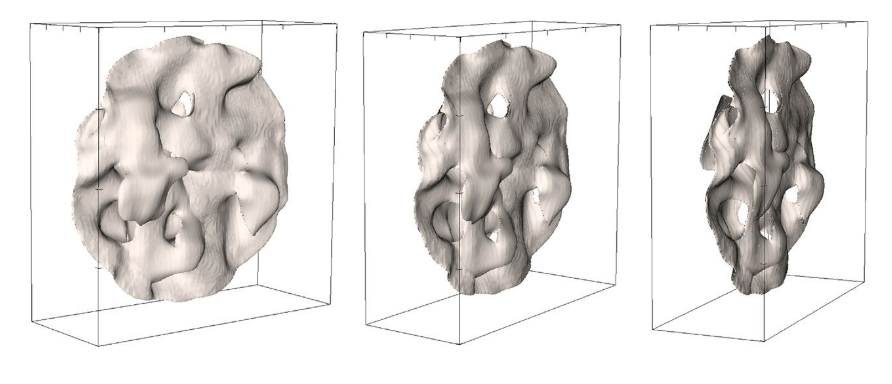Giant Molecular Clouds, Clumps and Filaments
We are also interested in giant molecular clouds (GMCs); sometimes referred to as 'stellar nurseries'. It is within the most dense regions of these clouds that star formation primarily occurs and so the processes that destroy or generate these clouds will therefore be responsible for the regulation of galactic star formation.
The thermal instability is a key process in the formation of molecular clouds, clumps and cores, leading to the formation of stars. Consequent stellar feedback, through winds and SNe, is a key process in understanding the evolution of these clouds and the triggering of further star formation. We study this by performing three-dimensional magnetohydrodynamic simulations of the formation of sheet-like molecular clouds with self-gravity. In projection these clouds appear filamentary, the models can be seen in the figure below.

Three different views of the same 3D iso-surface of constant density (10 cm-3) illustrating the corrugated nature of the single sheet formed when magnetic fields are considered. Length is scaled in units of 50 pc. Image credit: C. J. Wareing et al. 2016, MNRAS,459,1803-1818
The star formation rate is thus closely linked to the dyamics of the intersteallar medium (ISM) and thus directly regulated by processes like gravitational, thermal and magnetohydrodynamical instabilities and stellar feedback. Using numerical simulations we study the formation and evolution of GMCs in isolation and within the context of galaxies.
Interestingly the numerical codes used in this work can be employed to consider a wide range of physical situations; recently members of the group have used these tools to consider engineering applications related to pipe-bursts in Carbon Capture and Storage technologies.
